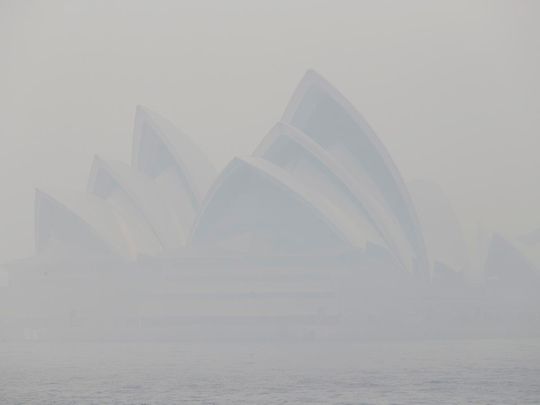
Sydney: Wildfires engulfed the Australian city of Sydney on Tuesday in haze so thick in some places it was 11 times worse than the level considered "hazardous," and was apt to trigger fire alarms.
The city canceled ferries and some offices in the downtown area were evacuated.
Local health officials advised people to stay indoors as much as possible and those with heart and lung problems were told to avoid all outdoor activity.
"The smoke here in Sydney is extremely bad today, it is some of the worst air quality we've seen," Richard Broome of New South Wales Health told reporters.
`"We are just urging people once again to take these (conditions) seriously,'' Broome said.
Ambulances have been answering dozens of respiratory-related calls a day, said the head of NSW Ambulance, Brent Armitage.
Sydney Trains warned that fire alarms at train stations might be set off by the thick smoke drifting into the city from fires ringing Sydney.
The regional environmental department said the air quality index, or AQI, in some parts of the city was more than 11 times the 200 reading considered hazardous.
Given the dire air quality, workers should not be forced to toil on outdoor job sites while the haze persists, said Unions NSW's assistant secretary, Thomas Costa.
"Toxicity is very, very high," Costa said.
Winds were expected that could clear the air but also fan the brush fires, weather forecasts showed.
The Sydney Opera House and harbor bridge were barely discernible through the thick haze enveloping the city, with smoke stinging the eyes and making it difficult to breathe.
The Air Quality Index compiled by the state environment department reached as high as 2,552 in some eastern suburbs - soaring past the "hazardous" threshold of 200. The pollution has been so bad it has set off smoke alarms in office buildings across the CBD, while ash has been washing up on the city's usually pristine beaches. Flight arrivals at Sydney Airport were delayed by up to 30 minutes due to poor visibility.
Temperatures are forecast to soar to 42 degrees Celsius in the city's west. Rural Fire Service Commissioner Shane Fitzsimmons, who is leading efforts to tackle more than 80 blazes across the state of New South Wales, said it would be a "very complex, very difficult day" for his team.
Some 2.7 million hectares of land, with a perimeter of 19,235 kilometers, have been burnt so far this bushfire season.
The ferocious and early start to the fires this year has stoked a debate around whether Australia's government - a champion of the coal industry - is doing enough to curb greenhouse gas emissions. Prime Minister Scott Morrison has repeatedly shut down claims that his government's approach to climate change has contributed in any material way to the current bushfire emergency.
The devastating fire conditions were referenced several times at an energy summit in Sydney on Tuesday, where Matt Kean, the NSW state minister for the environment, said a transition to clean energy was inevitable.
"Let's call it for what it is: these bushfires have been caused by extreme weather events, high temperatures, the worst drought in living memory - the exact type of events scientists have been warning us about for decades that would have been caused by climate change," said Kean.
The wildfires have generated more hotspots in the past two days than any other country and the intensity of the blazes is greater than the rest of the world combined, according to NASA satellite data.
National Aeronautics and Space Administration satellites detected 5,748 hotspots in Australia over the past 48 hours, more than the total number found in Brazil, Indonesia and India.








